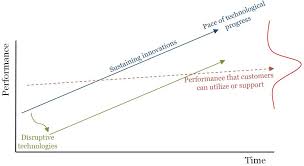Disruptive Innovation Examples: Changing the Game
Disruptive innovation refers to the process by which a new product, service, or technology disrupts and reshapes an existing market or industry. These innovations often start small but have the potential to revolutionise entire sectors. Let’s explore some notable examples of disruptive innovation:
Uber
Uber transformed the transportation industry by introducing a convenient and cost-effective alternative to traditional taxis. Through its ride-hailing app, Uber disrupted the way people commute in cities around the world, leading to significant changes in the taxi and car rental industries.
Airbnb
Airbnb revolutionised the hospitality sector by allowing individuals to rent out their homes or spare rooms to travellers. This peer-to-peer accommodation platform disrupted the hotel industry by offering unique and affordable lodging options, challenging traditional hotel chains.
Netflix
Netflix disrupted the entertainment industry by shifting from a DVD rental service to a streaming platform for movies and TV shows. By providing on-demand content accessible anytime, anywhere, Netflix changed how people consume media and posed a significant challenge to traditional television networks.
Tesla
Tesla disrupted the automotive industry by popularising electric vehicles and pushing boundaries in sustainable transportation. With its focus on innovation, design, and performance, Tesla has influenced major car manufacturers to invest more in electric vehicle technology.
Spotify
Spotify revolutionised the music industry by offering a vast library of songs for streaming on various devices. By providing a user-friendly platform with personalised recommendations, Spotify disrupted traditional music distribution models and changed how people access and listen to music.
These examples demonstrate how disruptive innovation can challenge established norms, create new opportunities, and transform industries in profound ways. As technology continues to advance rapidly, we can expect more disruptive innovations to emerge and shape our future.
Strategies for Embracing Disruptive Innovation: 8 Key Tips for Success
- 1. Look for opportunities to create new markets with products or services that cater to unmet needs.
- 2. Keep an eye on emerging technologies that have the potential to disrupt existing industries.
- 3. Encourage a culture of experimentation and risk-taking within your organisation.
- 4. Be open to collaboration with startups and other external partners who may bring fresh perspectives.
- 5. Monitor customer feedback and market trends closely to identify areas ripe for disruption.
- 6. Stay agile and adaptable in response to changing market conditions and competitive threats.
- 7. Invest in research and development to stay ahead of the curve in your industry.
- 8. Continuously evaluate your business model and be willing to pivot if necessary to embrace disruptive innovation.
1. Look for opportunities to create new markets with products or services that cater to unmet needs.
When considering disruptive innovation examples, one key tip is to seek opportunities to establish new markets by offering products or services that address unmet needs. By identifying gaps in existing industries and developing solutions that resonate with consumers, businesses can introduce disruptive innovations that challenge traditional market dynamics. This proactive approach not only allows companies to differentiate themselves but also paves the way for transformative changes that have the potential to redefine entire sectors.
2. Keep an eye on emerging technologies that have the potential to disrupt existing industries.
To stay ahead in today’s rapidly evolving business landscape, it is crucial to keep a vigilant watch on emerging technologies that possess the capability to disrupt established industries. By monitoring and understanding these new technologies, businesses can proactively adapt their strategies and operations to leverage opportunities presented by disruptive innovations. Being proactive in identifying and embracing these technological advancements can help organisations not only survive but thrive in an ever-changing market environment.
3. Encourage a culture of experimentation and risk-taking within your organisation.
To foster disruptive innovation within your organisation, it is crucial to encourage a culture of experimentation and risk-taking. By creating an environment where employees feel empowered to explore new ideas, test unconventional approaches, and take calculated risks, you can unlock the potential for groundbreaking innovations to emerge. Embracing experimentation allows for learning from both successes and failures, leading to valuable insights and opportunities for growth. Encouraging a culture that values innovation and embraces risk-taking can pave the way for transformative changes that drive your organisation forward in a rapidly evolving landscape.
4. Be open to collaboration with startups and other external partners who may bring fresh perspectives.
To effectively leverage disruptive innovation, it is crucial to remain open to collaboration with startups and external partners who can offer fresh perspectives and innovative solutions. By engaging with these external entities, organisations can tap into new ideas, technologies, and approaches that may not be readily available internally. Collaborating with startups and other partners can help foster a culture of creativity, experimentation, and continuous learning, ultimately driving growth and competitive advantage in today’s rapidly evolving business landscape.
5. Monitor customer feedback and market trends closely to identify areas ripe for disruption.
Monitoring customer feedback and market trends closely is crucial when seeking disruptive innovation opportunities. By staying attuned to what customers are saying and observing shifts in the market, businesses can identify areas that are ripe for disruption. Customer feedback provides valuable insights into unmet needs or pain points that traditional solutions may not address adequately. Similarly, tracking market trends allows companies to anticipate changing demands and emerging technologies that could potentially disrupt existing industries. By proactively monitoring feedback and trends, organisations can position themselves to introduce innovative solutions that meet evolving customer expectations and reshape markets.
6. Stay agile and adaptable in response to changing market conditions and competitive threats.
In the realm of disruptive innovation, it is crucial to stay agile and adaptable in response to changing market conditions and competitive threats. By remaining flexible and open to adjustments, businesses can effectively navigate the dynamic landscape created by disruptive technologies and emerging competitors. Agility enables organisations to quickly pivot strategies, embrace new opportunities, and address challenges proactively, ensuring they stay ahead of the curve in an ever-evolving market environment. Embracing adaptability as a core principle allows companies to not only survive but thrive amidst disruptive forces, positioning themselves for sustained success in the long term.
7. Invest in research and development to stay ahead of the curve in your industry.
To stay ahead of the curve in your industry, it is essential to invest in research and development. By allocating resources to innovation and exploring new technologies, businesses can position themselves as leaders in their field. Investing in R&D allows companies to anticipate market trends, develop cutting-edge products or services, and adapt to changing consumer demands. Embracing disruptive innovation through continuous research and development efforts enables organisations to remain competitive and agile in an ever-evolving business landscape.
8. Continuously evaluate your business model and be willing to pivot if necessary to embrace disruptive innovation.
To thrive in a rapidly changing business landscape, it is crucial to continuously assess your business model and remain open to pivoting when needed to embrace disruptive innovation. By staying agile and adaptable, businesses can proactively respond to market shifts, technological advancements, and evolving consumer preferences. Being willing to pivot allows organisations to capitalise on new opportunities, stay ahead of competitors, and drive sustainable growth in the face of disruptive forces. Embracing change as a strategic imperative can position businesses for long-term success in an era defined by innovation and disruption.




